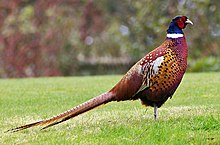
Back تدرج (طائر) Arabic Pirew ka kinokotowetc ATJ মথুরা (পাখি) Bengali/Bangla Fazan Breton Faisà Catalan Bažant Czech Fasan German Φασιανός Greek Fazano Esperanto قرقاول (سرده) Persian
This article needs additional citations for verification. (August 2020) |
| Pheasant | |
|---|---|

| |
| Mongolian ringneck-type common pheasant Male | |
| Scientific classification | |
| Domain: | Eukaryota |
| Kingdom: | Animalia |
| Phylum: | Chordata |
| Class: | Aves |
| Order: | Galliformes |
| Superfamily: | Phasianoidea |
| Family: | Phasianidae |
| Groups included | |
| Cladistically included but traditionally excluded taxa | |


Pheasants (/ˈfɛzənt/ FEH-zənt) are birds of several genera within the family Phasianidae in the order Galliformes. Although they can be found all over the world in introduced (and captive) populations, the pheasant genera's native range is restricted to Eurasia. The classification "pheasant" is paraphyletic, as birds referred to as pheasants are included within both the subfamilies Phasianinae and Pavoninae, and in many cases are more closely related to smaller phasianids, grouse, and turkey (formerly classified in Perdicinae, Tetraoninae, and Meleagridinae) than to other pheasants.[1]
Pheasants are characterised by strong sexual dimorphism, males being highly decorated with bright colours and adornments such as wattles. Males are usually larger than females and have longer tails. Males play no part in rearing the young.
A pheasant's call or cry can be recognised by the fact it sounds like a rusty sink or valve being turned.
Pheasants eat mostly seeds, grains, roots, and berries, while in the summer they take advantage of insects, fresh green shoots, spiders, earthworms, and snails. However, as an introduced species, in the UK they are a threat to endangered native adders.[2][dubious – discuss]
The best-known is the common pheasant, which is widespread throughout the world, in introduced feral populations and in farm operations. Various other pheasant species are popular in aviaries, such as the golden pheasant (Chrysolophus pictus).
- ^ Kimball, Rebecca T.; Hosner, Peter A.; Braun, Edward L. (2021-05-01). "A phylogenomic supermatrix of Galliformes (Landfowl) reveals biased branch lengths". Molecular Phylogenetics and Evolution. 158: 107091. doi:10.1016/j.ympev.2021.107091. ISSN 1055-7903. PMID 33545275. S2CID 231963063.
- ^ Nicolas Milton (1 Oct 2020). "Game birds 'could wipe out adders in most of Britain within 12 years'". Guardian newspapers.